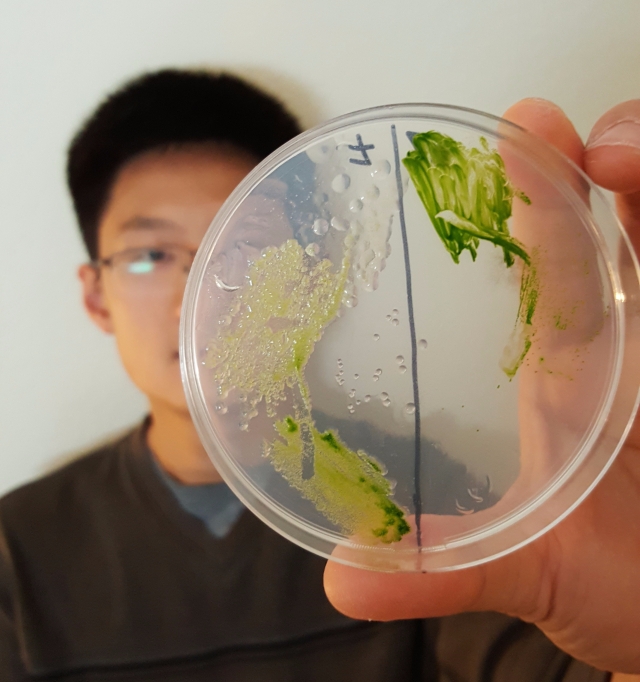Here is a picture of Brachionus, another rotifer I found in the water of a puddle right outside my high school:

While in the title of this post I assigned it the species name B. quadridentatus, I really don’t know what species this is. I’ve tried looking through some online keys and other resources, but that hasn’t really been helpful, especially since many of the rotifers in this genus and its encompassing family, Brachionidae, can vary in appearance greatly. It’s perhaps possible that this might be a hornless variant of B. quadridentatus, that normally looks like this:
(It’s an older video from a YouTube channel I used to use, before I got a new microscope, a new camera, and a better taste in music and video editing). Another couple of possibilities are B. rubens and B. urceolaris. But as I can’t be sure, I’ll just speak more broadly about all species of Brachionus on this post.
Brachionus is probably one of the best well-known genera of rotifers, and certainly one of the only to be of any commercial importance to people. It’s cultured heavily, essentially farmed for use in the aquarium industry, where it serves as a very nutritious food for fish fry. Many fish, when they are born, are too small to eat processed food like flakes or pellets, and they also haven’t learned to accept that type of food (they have an instinct to hunt live prey); rotifers happen to be a natural part of many of their diets, and Brachionus a particularly fast-growing, easy-to-grow group of them. The species B. calyciflorus and B. plicatilis are most commonly used, although I have yet to see them in the wild. These rotifers are also used in studies of freshwater ecology, where they serve as model organisms – basically the quintessential rotifer from which scientists can deduce other aspects of their biology and extrapolate them to other, harder-to-find and harder-to-grow species – so I think that they are some of the best-characterized rotifers all around. That being said, many species were first recorded hundreds of years ago (in the 1800s or even in the 1700s, including some by Mr. Müller again), and current information on them is somewhat scarce.

All of these rotifers share many features in common: a tough, inflexible shell or lorica which is typically round in shape, a thin tail, rings of cilia on fleshy lobes (which the rotifer can retract into its shell for protection), numerous “teeth” or spines at the top and/or bottom of their lorica (see next picture), conspicuous eggs carried on the back of the lorica, and a single red eyespot. They are generally moderately-sized (I measured one individual, which had a lorica about 220 microns in length, 190 microns in width, and a tail about another 190 microns long).

Over the years, I’ve seen probably half a dozen different species of Brachionus (and very closely related species in the genera Platyias), but all of the other species came from permanent bodies of water like ponds and lakes. This individual is of course from a temporary body of water, but it is not unique; in fact, it’s possible to buy eggs from supply companies to start cultures. They can emerge, grow, feed and reproduce, completing their life cycle in as few as three days (starting to lay eggs after only about 36 hours); however, I did not find them in the first few days after having collected my water samples. It is only after the Epiphanes rotifers that dominated the water sample died off that I really began to notice the Brachionus, so I suspect that while they are less competitive head-to-head in the initially algae-rich waters, they are more resilient when the algae are all eaten up and the water has aged a little bit more, so they continue to survive. One final thing I will note about this species: it swims very quickly. If it’s freely roaming around in the water, it will travel several body lengths (a millimeter or two) per second in a mostly linear direction while rotating slowly along its symmetrical axis. It looks pretty cool in the jar (as they’re just visible as a speck to the naked eye), but it’s absolutely torturous to try and follow under the microscope.
Alright…I don’t know what I’m going to do for my next post, so I’ll explore a few options, maybe post my first piece on this blog about algae themselves. I’ll probably end up writing more about my algae as I gradually focus my Experiment blog down to the technical details of its project; all of my side work will come here, I expect. So that’s a basic profile for Brachionus, covering the genus broadly and discussing the specifics of this one puddle population. Stay tuned.
Works cited:
Allen, R., 1998. Standard guide for acute toxicity test with the rotifer Brachionus. American Society for Testing and Materials West. 91.
Haney, J.F. et al. “An-Image-based Key to the Zooplankton of North America” version 5.0 released 2013. University of New Hampshire Center for Freshwater Biology <cfb.unh.edu>
Schlüter, M. (1980). Mass culture experiments with Brachionus Rubens. Hydrobiologia, 73(1), 45-50.
Suga, K., Tanaka, Y., Sakakura, Y., & Hagiwara, A. (2011). Axenic culture of Brachionus plicatilis using antibiotics. Hydrobiologia, 662(1), 113-119.





